Posted by Anita on 09.12.09 10:18 PM

Sorry it’s been a little quiet around here. We’ve experienced some technical difficulties, but mostly we’ve just been busy, happily squeezing a lot of fun into a low-budget summer.
But as lovely as our summer was, the last few weeks have been rough for some of our nearest friends. Too many have said goodbyes to family members and beloved pets, and we’re feeling all the more thankful for the many blessings in our own lives.
A little further afield, last week brought a nightmare to one of our favorite local food suppliers. Soul Food Farm — home to our favorite pastured chickens and one of our regular sources of pastured eggs — was hit by a devastating fire in the middle of the night. Despite heroic efforts by farmers Alexis and Eric Koefoed (and their family and neighbors), they lost so much:
Two chicken houses caught on fire, and we lost 1,000 baby chicks. Trapped. Our old 1880s barn burned and it was almost too much at that moment. Thirty acres of pasture for the meat birds is gone and several old beautiful oaks, all the old plum trees that were our connection to the original homesteaders.
I know times are tight for so many, so I hesitate to ask you for help. But I also know — from the fabulous response we’ve had to Menu for Hope each year — there are many generous folks out there. If your finances allow, consider one of the following:
-
Donate directly to the Soul Food Farm recovery effort via Pay Pal.
- Buy tickets for the raffle that Bi-Rite Market is holding.
- Reserve a seat at one of the upcoming benefit dinners.
If you can’t afford the extra expense of donation, there are other ways to help:
- Join the Soul Food Farm chicken-and-egg CSA, which is starting soon.
Your membership fees will help give the farm much-needed cash flow.
- Volunteer for one of the upcoming farm work-days to help rebuild.
If you’re not particularly handy, there will be some non-construction chores.
- Consider shifting your chicken and egg purchases to Soul Food’s products.
Prather Ranch sells both items; check the SFF site for more outlets.
(Updated 9/15: Added a link above to Eater SF’s roundup post on the benefit dinners)
farms & farmers, giving back, other stuff
2 Comments »




Posted by Anita on 08.17.09 10:12 PM
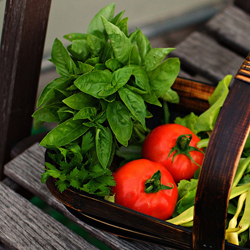 Years ago, I knew a guy who fancied himself a gourmet cook, even though his culinary skills were marginal at best. His one saving grace, kitchen-wise, was his signature pasta dish: Linguine combined with mozzarella — right in the hot pasta pan, so it got all stringy — then tossed with ripe tomatoes, loads of garlic, and a bunch of basil.
Years ago, I knew a guy who fancied himself a gourmet cook, even though his culinary skills were marginal at best. His one saving grace, kitchen-wise, was his signature pasta dish: Linguine combined with mozzarella — right in the hot pasta pan, so it got all stringy — then tossed with ripe tomatoes, loads of garlic, and a bunch of basil.
It was a good meal, even great when the seasons were right, but its real charm was its artlessness: No measuring, no fancy technique; just good food, simply prepared.
Even though tomatoes, mozzarella, and basil is a classic summer combination, I hadn’t thought of this pasta for years until I read our friend Jennifer’s post last week, where she described a remarkably similar dish. Her version keeps the cheese separate until the end, uses a combination of Mediterranean herbs, and omits the garlic. In a way, it’s a lot like seeing an old friend again after a long absence: A few things have changed, but the basic features are unmistakable.
For this week’s One Local Summer dinner, we whipped up a batch this new/old favorite, using some of the first tomatoes from our garden, along with basil, parsley, and chives from the herb beds. We used our favorite local pasta from Eduardo’s, a dense, wheaty fusilli. If you use a similar hearty pasta, this recipe makes four generous servings.

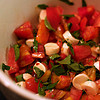



Pasta alla Jenblossom
— adapted from Last Night’s Dinner
4 to 5 ripe tomatoes (enough for 4 cups coarsely chopped)
~1 cup fresh herbs, coarsely chopped (I used 3/4 cup basil, 1/4 cup parsley, 2T chives)
2 cloves garlic, pressed
1/2 tsp crushed red chile flakes
sea salt, to taste
8oz good-quality dried pasta
3T olive oil
8oz fresh mozzarella, cut into smallish chunks
Put a pot of well-salted water on to boil. Meanwhile, chop the tomatoes into large chunks, and combine in a large bowl with herbs, garlic, chile, and sea salt. Toss and let sit to combine.
Boil your pasta according to package directions, stopping at the al dente stage. Just before the pasta is done, combine tomatoes with the olive oil and mozzerella. Drain the pasta and add it to the bowl with the tomatoes. Toss well and let sit it soak for as long as you can bear the heavenly smell of summer. Enjoy warm or at room temperature.
Farmers and food artisans who created the ingredients for this week’s recipe: Thomas Family Farm
Thomas Family Farm, Corralitos: Hard-neck garlic
Bariani, Sacramento: Olive oil
Belfiore Cheese Company, Berkeley: Bocconcini
Eduardo’s, San Francisco: Pasta
…and our homegrown tomatoes(!), basil, parsley, chives
locavore, One Local Summer, other blogs, recipes
10 Comments »




Posted by Anita on 08.10.09 8:13 PM
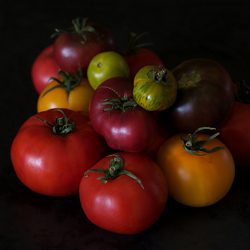 It’s finally happening: We’re finally harvesting enough fresh vegetables from our garden to make a meal, or most of one. True, this week we still bought tomatoes — although, look how gorgeous they are… can you blame us? By next week at this time, when our first branch of tomatoes is fully ripe, we’ll be able to make this recipe without much help from the farmers. This time around, we’re proud enough that half the bulk of our One Local Summer dinner for the week came straight from the yard.
It’s finally happening: We’re finally harvesting enough fresh vegetables from our garden to make a meal, or most of one. True, this week we still bought tomatoes — although, look how gorgeous they are… can you blame us? By next week at this time, when our first branch of tomatoes is fully ripe, we’ll be able to make this recipe without much help from the farmers. This time around, we’re proud enough that half the bulk of our One Local Summer dinner for the week came straight from the yard.
To celebrate this harvest milestone, I wanted to make sure that we found a recipe that wasn’t diluted with a lot of extraneous stuff. Looking at our bumper cucumber crop, I immediately though of Greek salad, but every recipe I found was almost half lettuce — which seemed a little counter to the occasion. Our lettuce patch is eking along pretty well in our mild coastal climate — we’ll have enough to spare for the BLT Challenge later in the month — but it seems a little sacrilegious to bulk up fresh tomatoes and cucumbers with a bunch of leaves. So I improvised a simple salad, and both of us were extremely happy with the results.
We served our garden bounty alongside a coil of grilled Basque-style sausage from our friends at Fatted Calf, and scooped everything up with a batch of homemade pita bread, made with a mix of locally grown whole-wheat flour (from Eatwell Farm) and locally milled Giusto’s bread flour. It was, if I dare say so, a feast fit for a Mediterranean deity.
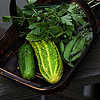
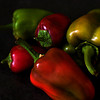



Greek Salad
3/4 pound tomatoes, cut into chunks (about 2 cups)
2 cups cucumber, peeled and seeded if desired, and cut into chunks
1/2 cup diced sweet red pepper
1/4 cup thinly sliced red onion
3 T extra-virgin olive oil
1-1/2 T red wine vinegar
3 T chopped Italian parsley
2 T fresh mint
1 T fresh oregano
1 T chives
—
1/4 cup crumbled feta cheese (about 2 ounces)
Toss all ingredients except feta in medium bowl to blend. Gently mix in cheese, and season with salt and pepper.
Farmers and food artisans who created the ingredients for this week’s recipe:
Lucero Organic Farms, Lodi: Heirloom tomatoes
Capay Fruits & Vegetables, Capay: red peppers
Catalán Family Farm, Hollister: Red onions
Bariani, Sacramento: Olive oil
O Olive Oils, San Rafael: wine vinegar
Spring Hill Cheese Company, Petaluma: Feta cheese
…and our homegrown cucumbers, parsley, mint, oregano, and chives
garden, locavore, One Local Summer, recipes
7 Comments »




Posted by Cameron on 08.02.09 8:59 AM
 We were caught unawares, but isn’t that how it always happens? It seemed an innocent enough Sunday cruise through the Marin Farmers Market, looking for the coming week’s dinners. With a Marin Sun Farms chicken and some Devil’s Gulch pork chops already safely tucked away, we drifted into the Santa Rosa Seafood tent and were suddenly entranced.
We were caught unawares, but isn’t that how it always happens? It seemed an innocent enough Sunday cruise through the Marin Farmers Market, looking for the coming week’s dinners. With a Marin Sun Farms chicken and some Devil’s Gulch pork chops already safely tucked away, we drifted into the Santa Rosa Seafood tent and were suddenly entranced.
Odysseus could hardly have been more enraptured by the Sirens than we were enchanted by the beautiful, sleek, glossy-eyed fishies staring out from their beds of crushed ice. Sorting out which finny critters had been caught locally took some shouting between the guys working the floor and the fishwives (well, hell… what else are you going to call them?) gutting customers’ orders, but eventually we learned that the bright red, medium-sized rosefish had been hauled out of the water near Monterey. Not only were these guys beautiful, they were also just the right size for one of the few Thai dishes that I can claim as my own: whole fried fish.
Now, this is no batter-dipped chip buddy — it’s an entirely different kettle of… er… fish. A typical batter crisps up while leaving the fish underneath tender. But to cook a whole fish Thai style, you cut a series of deep slashes in its flanks, dust it with tapioca starch and drop it — fins and all — into hot oil for an extended bath: 20 minutes or more. This treatment drives the water out of most of the meat, turning it into a delicious, chewy, crunchy treat that comes off the skeleton in bits that are perfect for dipping in tamarind-based hot sauce. I’ll leave it up to you whether to let your guests in on the secret treats: The fins and tail (and in some cases the exposed bones) become as crunchy as potato chips, and there are plenty of succulent bits to be had in and around the head.
But our story isn’t quite done yet. We were within a hair of being able to make this our One Local Summer dinner for the week, but the sauce recipe calls for tamarind — not exactly a Bay Area native. Fortunately, I roll with the McGuyver of the Kitchen, who suggested that (local) pluots combined with lime juice would bring the necessary tang and body to our dipping sauce.
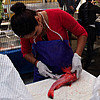

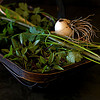

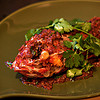
Crispy Fried Fish with Chili-Tamarind Sauce
– adapted from a recipe by Kasma Loha-unchit
A 1-1/2# firm, white-fleshed fish (such as snapper or perch), scaled and cleaned
1/4 tsp sea salt
1/8 tsp ground white pepper
8 cloves garlic, minced
4 fresh red jalapeño or Fresno peppers, minced*
2 shallots, minced
1-inch section fresh peeled fresh ginger, minced fine
1 T minced cilantro roots (or stems)
10 white peppercorns
2 to 3 cups peanut oil (for frying)
3 to 4 T tapioca starch
2 to 3 T Thai fish sauce
1/2 cup thick tamarind puree
1 T palm sugar, or more to taste
1/2 cup Thai basil leaves
A few sprigs of cilantro or Thai basil for garnish
2 to 4 Thai bird chiles, sliced thin, for garnish
Check to see that all the scales have been removed from your fish, and that the innards/guts are removed. Using a sharp knife, cut 3 to 5 deep gashes (depending on the size of the fish) in each side of the fish. The cuts should be at a 45-degree angle to the midline of the fish, with the top of each cut closer to the head and the bottom closer to the tail. Rinse the fish, drain, and pat dry. Rub evenly with a thin coating of salt and white pepper. If the fish has been refrigerated, let sit out up to an hour to warm to room temperature before frying.
Mix the garlic, peppers, shallots, ginger, and cilantro roots/stems. Using a large, heavy mortar and pestle, pulverize the peppecorns. Then add the minced aromatics, stir to mix well, and pound to a smooth paste.
Heat the oil in a wok over high heat until a bit of tapioca starch (or other test tidbit) dropped in the oil begins to bubble almost immediately. Coat the fish with a very thin layer of tapioca starch, and slip it into the oil. Fry the fish, turning it and ladling oil over it as necessary, until it is browned and crispy on both sides from head to tail (about 10 minutes on each side). Manage the flame to keep the oil bubbling vigorously, but not frantically, so that the fish can crisp thoroughly without burning. Remove the fish from the oil and cool on a wire rack for a few minutes before placing on a serving platter.
Pour off the oil from the wok, except for two tablespoons. Add the pounded chili mixture and sauté over medium heat for 2 to 3 minutes. Add fish sauce, tamarind, and palm sugar until the spicy, sour, sweet, and salty flavors are equally balanced. The sauce should be the consistency of a thick salsa — thin with water if it becomes too dry. Cook a minute to blend the flavor, then stir in the basil and cook just enough to wilt.
Spread half the sauce evenly over the fish and the other half along sides of the platter. Garnish with cilantro or Thai basil sprigs and the sliced chiles.
* Note: Do not seed the chilies unless you wish the sauce to be mild. For a medium-hot dish, remove the seeds from half the chilies.
Farmers and food artisans who created the ingredients for this week’s recipe:
Santa Rosa Seafood, Santa Rosa: Rosefish (Monterey-caught)
Hunter Orchards, Grenada: Garlic
Xiong Farm, Fresno: Thai bird chiles, Fresno chiles, ginger
Dirty Girl Produce, Santa Cruz: Shallots
Kashiwase Farms, Winton: Pluots
Paradez Farms, Exeter: Limes
…and our own homegrown Thai basil and cilantro
locavore, One Local Summer, recipes, Thai
3 Comments »




Posted by Anita on 07.26.09 11:30 PM
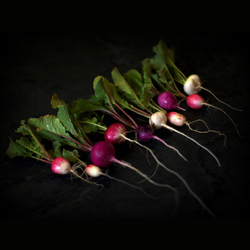 This week, we had so much going on that we lost track of our One Local Summer meal entirely. It’s not that we didn’t enjoy lots of fresh, fabulous treats from the market and our garden, we just weren’t diligent about documenting any of them. Many dinners were repeats of past OLS post, or just the kind of no-recipe suppers thrown together on a summer evening.
This week, we had so much going on that we lost track of our One Local Summer meal entirely. It’s not that we didn’t enjoy lots of fresh, fabulous treats from the market and our garden, we just weren’t diligent about documenting any of them. Many dinners were repeats of past OLS post, or just the kind of no-recipe suppers thrown together on a summer evening.
We’d planned to make up for lost time at the end of the week, but other things came up — a touch of a sore throat, followed by a last-minute weekend trip — and we found ourselves empty-handed for this week’s roundup.
Luckily, we had something we’ve kept in our back pocket in case of just such an eventuality. We first tossed this simple salad together back at the end of May, just as we were reaching the end of our first shelling pea crop. The plants had begun to die off, and we were ready to turn them back into the soil and plant another crop. But there were just enough peas left for one last splurge.
And actually, it’s the perfect salad to enjoy at the beginning of a pea harvest, too — a place we find ourselves this week, with our second pea crop — or any other time you’ve got a mixture of mature peas, immature pods, and a few small tendrils. If you’re a cleverer gardener than we are, and you’ve mastered the art of successive plantings, you can even use the thinnings from your next batch of peas, too.
But even if you buy every last stitch from the farmers market, you’ll be rewarded with a light, fragrant salad, equal parts crisp and creamy.





Pea and Radish Salad with Feta
– loosely adapted from Bon Appetit
1 tsp cumin seeds
1 T fresh lemon juice
1/2 tsp honey
2 T extra-virgin olive oil
3 springs fresh thyme, leave stripped
1-1/2 cups fresh shelled peas
6-10 snow peas (or immature homegrown peas), julienned
5-7 medium radishes, thinly sliced
1/2 cup crumbled feta cheese (about 2 oz)
1-1/2 cups pea sprouts or very tender pea tendrils
Toast the cumin seeds in a small skillet over medium heat until aromatic, about 2 minutes. Cool the seeds, then grind in a spice mill or coffee grinder. In a small bowl, whisk together the dressing ingredients (cumin to thyme); season to taste with salt and pepper, keeping in mind that feta can be quite salty.
Blanch the peas in boiling salted water until just tender, about 3 minutes. (Timing will vary based on freshness, age, and size of peas.) Scoop peas out of the pan and into an ice-water bath. Repeat blanching with the snow-pea strips; this will take about 1-2 minutes.
Drain peas and snow pea strips very well. Combine them in a medium bowl with the sliced radishes and crumbled feta. Drizzle with about half the dressing and toss. Taste and add more dressing, salt, and pepper as needed.
Divide pea sprouts or tendrils among 2 or 3 wide salad bowls, and top with the dressed salad. Serve at once.
Farmers and food artisans who created the ingredients for this week’s recipe:
Marshall’s Farms, American Canyon: Honey
Bariani, Sacramento: Olive oil
Spring Hill Cheese Company, Petaluma: Goat feta
…and our own homegrown lemons, thyme, peas, and radishes
locavore, One Local Summer, recipes
5 Comments »




Posted by Anita on 07.19.09 10:22 PM
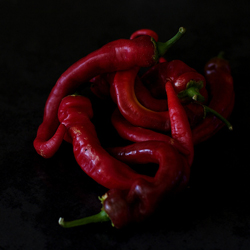 At this time of year, when the garden’s finally kicking into high gear, and all of our favorite foods are in plentiful supply at the farmers market, I rarely pick up a cookbook, and hardly even use recipes.
At this time of year, when the garden’s finally kicking into high gear, and all of our favorite foods are in plentiful supply at the farmers market, I rarely pick up a cookbook, and hardly even use recipes.
The vast majority of our summer meals follow a dead-easy formula: A little bit of meat, usually rubbed or marinated and then seared on the grill; an unfussy starch, finished with a knob of fresh butter or a drizzle of olive oil; and big helping of vegetables, either in the form of a chopped salad or a simple saute. Usually, there’s fruit for dessert — maybe paired with ice cream or cookies, if we’re feeling fancy.
The few recipes that find their way out of the files are usually tried-and-true favorites, and this one is no exception. We’ve been making this succotash for nearly three summers now — it first appeared on the blog as a passing reference back in 2006 — and it feels like an old friend. We’re finally seeing peppers in the market, so we hauled it out for the first time this summer, and enjoyed it as the centerpiece of this week’s One Local Summer meal, alongside a grilled tri-tip with a Santa Maria-style rub (equal parts salt, pepper, and garlic granules, moistened with olive oil).
We’ve made some changes to the succotash recipe along the way, swapping out the original’s summer squash (which neither of us really likes) in favor of other summery flavors like green garbanzos or late-season peas. But no matter how many tweaks we make, it remains one of those tastes of summer that we anticipate all year long.


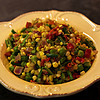

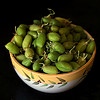
Summer Succotash
– adapted from Bon Appetit
1T extra-virgin olive oil
1 cup chopped onion
1 cup diced sweet red pepper
1-1/2 tsp fresh thyme leaves
2 garlic cloves, minced
4 ounces slender green beans, trimmed, cut into 3/4-inch pieces (~1 cup)
1/2 cup green garbanzos (or substitute mature favas or starchy peas)
1 cup fresh corn kernels (cut from 2 ears of corn)
2T cream
Heat oil in large skillet over medium-high heat. Add onion; reduce heat to medium and saute until beginning to soften, 2 to 3 minutes. Add pepper, thyme, and garlic; saute 1 minute. Add garbanzos and 1/4 cup of water; cover and cook until the garbanzos are just beginning to soften, 4 to 6 minutes longer. Add the green beans and saute until all vegetables are crisp-tender, about 4 minutes more. Stir in corn and cream, and saute until just heated through. Remove from heat, season with salt and pepper, and serve immediately.
Farmers and food artisans who created the ingredients for this week’s meal: Bariani
Bariani, Sacramento: Olive oil
Everything Under the Sun, Winters: Red onions
The Peach Farm, Esparto: Red frying peppers
Hunter Orchards, Grenada: Garlic
Catalán Family Farm, Hollister: Green garbanzos
Pinnacle/Phil Foster Ranch, Hollister: Corn
Claravale Farm, Paicines: Raw Jersey cream
…and our own homegrown thyme and green beans
locavore, One Local Summer, recipes
6 Comments »




Posted by Anita on 07.14.09 12:33 PM
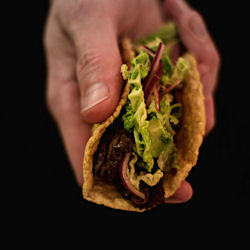 One day a couple of weeks ago, I decided to make a batch of homemade kimchi using an extra head of cabbage I had knocking around. Of course, this simple use-it-up kitchen project required a trip across town to a Korean grocery store for the requisite red-pepper seasoning mixture, but I’ve got an anti-food-waste streak a mile wide.
One day a couple of weeks ago, I decided to make a batch of homemade kimchi using an extra head of cabbage I had knocking around. Of course, this simple use-it-up kitchen project required a trip across town to a Korean grocery store for the requisite red-pepper seasoning mixture, but I’ve got an anti-food-waste streak a mile wide.
In a bit of kitchen synchronicity, I’d been meaning to make our friend Matthew‘s recipe for Korean tacos — a recent trip to L.A. left us with a hankering for this hipster street chow but unable to stomach Kogi‘s ridiculous 3-hour lines — and kimchi seemed like a natural accompaniment.
Last weekend at the farmers market, our list was very short. Knowing we were heading off to New Orleans last Wednesday, we really only needed to make one dinner at home. Could we combine our Korean supper with our One Local Summer meal? Turns out, the recipe doesn’t require any exotic ingredients, and by stretching our challenge’s seasoning exemptions to include soy sauce and a small amount of sesame oil, we were able to source everything we need from within our 100-mile radius.
Of course, the best-laid plans often lead to disappointment, and my first batch of kimchi never really got the hang of fermentation. I tried again a few days later using a different recipe, and although it seemed headed in the right direction, the cabbage never released enough liquid, and the result was dry and funky.
But although I still haven’t found a kimchi recipe that works for me, that didn’t stop me from including it in our locavore feast. Turns out, there’s a locally made brand — King’s — that all the nearby Asian markets sell. It’s spicy and fresh-tasting, even if it’s not as beautiful or as romantic as the homemade sort.
This recipe also gave us a chance to try out the meat slicer we bought a few weeks ago. If you don’t have a fancy gizmo like ours, you may be able to ask your butcher to shave the meat for you. Or, you can freeze it briefly (although not until it’s completely solid) and use a very sharp knife to cut pieces as thin as possible.
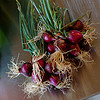
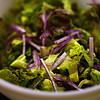
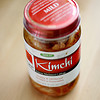
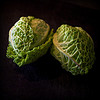
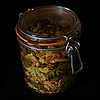
Korean Rib-Eye Tacos
– adapted from Matthew Amster-Burton
3/4 pounds rib eye, sliced paper thin
1T soy sauce
1 to 2T sugar
1T minced garlic
2 tsp Asian sesame oil
1 tsp sherry or mirin
1 tsp water
—
1-1/2 tsp soy sauce
3/4 tsp lime juice
3/4 tsp toasted sesame oil
2 cups shredded romaine lettuce
1 cup shredded Napa cabbage
1/4 cup thinly sliced red onion
toasted sesame seeds
—
chopped avocado
kimchi, Korean red pepper flakes, or fermented chili paste
corn tortillas (6 to 10, depending on size)
Combine the meat with the rest of the marinade ingredients, and refrigerate for between 2 and 24 hours. Bring meat to room temperature, then cook under a broiler or in a well-heated skillet. If needed, chop into smaller, taco-friendly pieces.
Whisk together the soy sauce, lime juice, and toasted sesame oil. Toss the lettuce, cabbage, and red onion in a large bowl with half of the dressing. Add more dressing to taste, then garnish generously with sesame seeds.
Warm the tortillas over a gas burner or in a dry skillet. Top with meat, slaw, avocado, and your choice of spicy condiments.
Farmers and food artisans who created the ingredients for this week’s meal: Marin Sun Farms
Marin Sun Farms, Point Reyes: Grass-fed pastured rib-eye steak
Hunter Orchards, Grenada: Garlic
Paradez Farms, Exeter: Limes
Marin Roots Farm, Petaluma: Romaine
Dirty Girl Produce, Santa Cruz: Cabbage
Mariquita Farm, Watsonville: Red onions
Will’s Avocados, Soledad: Avocados
Primavera, Sonoma: Corn tortillas
King’s Asian Gourmet, San Francisco: Kimchi
locavore, meat, One Local Summer, recipes
8 Comments »




Posted by Cameron on 07.10.09 9:08 AM

Originally posted on the Tales Blog, where we’re working with many other cocktail bloggers to cover Tales of the Cocktail, 2009.
As someone who has been to my share of trade shows and conferences, I can tell you that the phrase “convention lunch” is enough to strike fear into the heart of the boldest traveler. But this is Tales of the Cocktail, which is about as un-convention-al as it gets. You can count on a good time in the seminars, tasting rooms, and party rooms, and then stroll out to some seriously good food.
Yesterday was the perfect example. We rolled out of bed, still on Pacific Time and fuzzy from the previous night’s festivities, cleaned up a bit, and then hit the bricks, aiming for the river, Cafe du Monde, and beignets with cafe au lait. The beignets come three to a plate, snuggled into a pile of powdered sugar that looks like nothing so much as the scene in the third act of Scarface where Tony Montana plunges his face into a mountain of cocaine. Instead of our noses, we plunged our beignets into the fluffy white mound while a singing, trumpet-playing entertainer performed “Down by The Riverside,” “Danny Boy,” and other feats of musical daring for the amusement of passers-by.
On our way back to the hotel, our eyeballs vibrating ever so slightly from the sugar buzz, we realized that our “lunch” break wouldn’t come until 2:30, and that we needed something a bit more substantial to carry us through the day. So, we stopped at Johnny’s Po-Boys and split an egg and bacon po’boy, washed down with a couple of Barq’s root beer sodas. Mother’s may get more attention, but for our money, Johnny’s is the spot. It’s a place of wonderful mysteries. How do they manage to get the rolls to be tender, chewy, and flaky all at the same time? How can they offer fried chicken with a homemade biscuit and white gravy for $2.50 a plate? And how am I going to manage to get here enough times this week, given all the other great places that we’ll be eating at?
Back at Tales, we soaked up some knowledge and tasted some spirits, but I have to admit that I was already looking forward to our next food foray. We roped in Marshall from Scofflaw’s Den and headed back into the Quarter, aiming for Central Grocery and its famous muffuletas.
I had my first Central Grocery muffuletta at last year’s Tales, and it was a madhouse. There was a line out the door, and every horizontal surface was staked out by someone eagerly devouring one of the sandwiches. Today, there were no crowds, which made the lunchtime experience much more civilized. But even if it were wall-to-wall people, it wouldn’t have mattered. If there’s anything wrong with loving a sandwich the size and shape of a hubcap, spread with oily, tangy olive salad and filled with all sorts of good things (salami, capicola, and provolone, just to name a few), I don’t want to be right.
The best part? The day wasn’t over, much less the week. We have got to get to Green Goddess, and there’s a slew of other stuff on the schedule. And no matter where we are I’m pretty sure that there’s another plate of beignets calling my name, down by the riverside.





New Orleans, restaurants, Tales of the Cocktail
6 Comments »




Posted by Anita on 07.05.09 11:03 PM
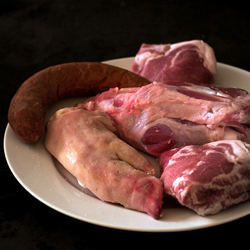 When I first read the recipe that served as the inspiration for this week’s One Local Summer supper in the September 2006 issue of Bon Appetit, I knew we would have to make it. The official name of the dish was the prosaic “Spanish Pork Braise”, but the real hook was rendered in 48-point type over a stunning photo of braised pork shanks and sunny garbanzo beans: “PORK x4”. Really, have you ever heard of a happier notion? Not just pork — pork four times over!
When I first read the recipe that served as the inspiration for this week’s One Local Summer supper in the September 2006 issue of Bon Appetit, I knew we would have to make it. The official name of the dish was the prosaic “Spanish Pork Braise”, but the real hook was rendered in 48-point type over a stunning photo of braised pork shanks and sunny garbanzo beans: “PORK x4”. Really, have you ever heard of a happier notion? Not just pork — pork four times over!
Of course, with September being the height of San Francisco’s Indian summer, the idea of a hearty braise heating up the house wasn’t really appealing at the time. But I knew, some foggy summer day in the future, I’d have the perfect recipe at hand.
Finding osso-bucco–style pork-shank pieces at the farmers market isn’t really an everyday occurrence (although Marin Sun Farms will do them by special order), so I never found myself hunting down the recipe. But then, last week, while browsing through my recipe file looking for a way to use up some porky odds and ends in the freezer, I rediscovered this captivating clipping. The pork shank I had on hand was whole — we’d brought it home from our pig-butchering class — but a braise is a braise is a braise. Even if pulled meat doesn’t look quite as nice as a neatly tied shank steak, it still tasted delicious.
The original recipe is served with a side of garbanzo beans dressed up with a sprinkling of gremolata. We were lucky enough to pick up fresh, green garbanzos at the market last week, and substituted them for canned, after a quick pan-poaching. If you’re wondering what to do with the starchy late peas you’re finding at the market, I suspect they’d made a great alternative, too.

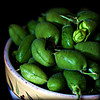
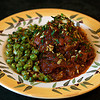


Pork Times Four
– adapted from Steve Johnson’s Spanish Pork Braise, Bon Appetit
4 to 5 pounds bone-in pork for braising
(such as a whole pork shank, or 6 x 2-1/2-inch thick shank pieces, or a meaty soup bone plus large chunks of shoulder meat)
1/2 pig’s foot
1 to 2 links Spanish-style chorizo, sliced
2 T extra-virgin olive oil
2 large carrots, medium dice
1 large onion, medium dice
6 large garlic cloves, smashed
1/2 T chopped fresh savory (or 1T chopped thyme)
1 cup medium-dry Sherry
1 28-ounce can plum tomatoes in juice, tomatoes coarsely chopped
2 cups pork (or chicken) stock
3 dried ancho chiles, halved, stemmed, seeded
2 T tomato paste
1-1/2 tsp ground cumin
1 tsp ground coriander
—
2T olive oil
3 cups cooked garbanzo beans
1 large clove of garlic, minced
large pinch of saffron
1/4 cup chopped parsley
2 thin slices proscuitto or ham, minced
1/2 cup chopped toasted almonds
1T grated citrus peel, preferrably orange
Preheat the oven to 350°F. Sprinkle pork and pig’s foot with salt and pepper. Heat a wide Dutch oven over medium heat, and add the chorizo slices. Saute the chorizo, adjusting heat as needed to render the fat and brown the meat. Remove the browned chorizo to a plate using tongs or a slotted spoon. Increase heat to medium-high, and saute the pork until brown, turning to caramelize all sides. (Depending on the size of your pan, you may need to work in batches. If your chorizo is particularly lean, you may need to add some additional oil.) Remove browned pieces to a plate or baking sheet, and reduce heat to medium low.
Add carrots, onion, garlic, and herbs to the pan, and cook until onion softens, about 4 to 6 minutes. Add the sherry to the pan, and deglaze. Add the tomatoes and their liquid, stock, chiles, cumin, and coriander. Bring to a boil, and return browned meat, chorizo, and pig’s foot to the pan. Return to a boil, then cover and place in the preheated oven. Braise until the meat is tender and just pulling away from the bone, 90 minutes to 3 hours.
When meat is cooked through, de-fat the sauce with a spoon. (Alternately, you can cool the mixture and refrigerate overnight; the fat will solidify and be easily removed the next day.) If the sauce remains chunky, you may want to remove the meat and puree it with a stick blender; if so, take care to leave some texture.
Heat oil in a skillet over medium-low heat. Add beans, garlic, and saffron, and saute until heated through. Mix in the proscuitto, and season to taste with salt and pepper.
Mix together parsley, almonds, and zest in a small bowl.
To serve, place equal amounts of pork on 6 plates, spooning sauce around. Serve garbanzos on the side, and sprinkle the whole plate with gremolata, reserving some to pass at the table.
Farmers and food artisans who created the ingredients for this week’s meal: Devil’s Gulch Ranch
Devil’s Gulch Ranch, Nicasio: Pork shank & picnic meat
Marin Sun Farms, Point Reyes: pig foot
Fatted Calf, Napa: Chorizo
Bariani, Sacramento: Olive oil
Mariquita Farm, Watsonville: Onion, savory
Hunter Orchards, Grenada: Garlic
Tierra Vegatables, Santa Rosa: Ancho chiles & carrots
Short Night Farm, Dunnigan: Green garbanzo beans
Boccalone, Oakland: Proscuitto
Star Route, Bolinas: Parsley
Alfieri Farms, Esaclon: Almonds
Paradez Farms, Exeter: Blood orange…plus our own home-canned tomatoes & paste (from Mariquita’s tomatoes), homemade pork stock, and homegrown coriander.
locavore, meat, One Local Summer, recipes
2 Comments »




Posted by Anita on 06.28.09 3:01 PM
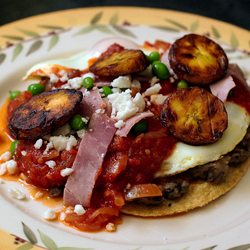 Two weekends ago, we ran into our friend Jeanne at the farmers market, as we often do. Jeanne had just returned from an East Coast trip, so we had a lot of catching up to do. But after chatting in the summer sun for a while, Cameron and I started to get antsy: We had to get home to start curing pork belly, the first step in making a batch of homemade bacon. Hearing this, Jeanne mentioned she’d always wanted to make her own bacon, but didn’t have the space for a smoker. “We have a smoker you can borrow whenever you want,” we offered. “Or, you could just come over next weekend, and smoke some bacon with us.”
Two weekends ago, we ran into our friend Jeanne at the farmers market, as we often do. Jeanne had just returned from an East Coast trip, so we had a lot of catching up to do. But after chatting in the summer sun for a while, Cameron and I started to get antsy: We had to get home to start curing pork belly, the first step in making a batch of homemade bacon. Hearing this, Jeanne mentioned she’d always wanted to make her own bacon, but didn’t have the space for a smoker. “We have a smoker you can borrow whenever you want,” we offered. “Or, you could just come over next weekend, and smoke some bacon with us.”
Jeanne is nothing if not determined: When she discovered that none of the farmers market vendors had any pork belly left, she scoured the City for a piece, so she could cure her own batch at home. Knowing that Jeanne and Cameron share a devotion to the Red Sox, I set the bacon-smoking time so that we could all listen to the game together: 10am Sunday. With pork curing in two fridges and the schedule nailed down, our discussions turned to more important things: What should we make for brunch?
“What do you think about huevos motuleños?” asked Jeanne, linking to her own recipe for the classic Mexican egg plate. “I think your fondness of things Mexican equals mine!” (She knows us well — it took me all of 30 seconds to agree.)
So last Sunday, Jeanne arrived right at 10am, with a bundle of cured pork belly, a bottle of homemade hibiscus-lemongrass agua fresca, and a ripe plantain. After we’d loaded up the smoker and dialed in the temperature, we popped back into the kitchen to finish up our brunch. As the sauce warmed, I refried the beans and crisped the tostadas; Cameron fried three sets of over-easy eggs to perfection (all at the same time!); and Jeanne sauteed the plantains and poured tall glasses of delicious agua fresca. Everything came together at just the right time — amazing what you can make happen when three avid cooks share the work. And so, as the smell of applewood began wafting in from the backyard, we sat down to a colorful and delicious Mexican brunch.
Despite its international origins, our team effort made a perfect One Local Summer feast. With the exception of the fried plantains — I claim a brunch-guest exemption! — everything in our meal came from local sources. It took a little creativity (substituting a salty local feta for Mexcian queso fresco) and a few extra steps to keep things locavore-friendly; you could certainly simplify things by using canned black beans and store-bought tostada shells if you weren’t as set on having an all-local feast.

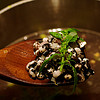



Huevos Motuleños
— adapted from World on a Plate
1-1/2 pounds ripe tomatoes
1 medium white onion, thinly sliced (divided use)
3 serrano chiles, cut into strips
—
1 ripe plantain, peeled and cut into 1/2-inch slices (optional)
2 cloves garlic, diced
1 to 2 cups black beans and their liquid
3 oz ham, cut into matchsticks or small dice
1/2 cup fresh peas, blanched or quick-braised
1 oz (about 1/4 cup) crumbled queso fresco or firm feta
8 eggs
4 corn tortillas
Roast the tomatoes on a rimmed baking sheet, 4 inches below a very hot broiler, until blistered and blackened, flipping to cook both sides. Cool tomatoes in a bowl, then peel while catching all the juices over the bowl. Coarsely puree the tomatoes and juice using a stick blender or in a food processor.
In a medium saucepan, heat 1T oil over medium heat. Add about 3/4 of the onion and saute, stirring regularly, until onions golden, about 8 minutes. Add the tomatoes and chile strips and simmer over medium-low heat for 15 minutes or so, stirring often, until the sauce is beginning to thicken but is still juicy. Season with salt to taste, and remove from heat to let the chiles steep.
(At this point, you can cool and refrigerate the sauce overnight.)
Pour a 1/2-inch depth of oil in a shallow skillet or frying pan. Warm the pan over medium heat until the oil shimmers. Add tortillas, one at a time, and cook until golden; flip with tongs and crisp the other side, then drain on a wire rack over newspaper or over a cookie sheet. Repeat with remaining tortillas until all are toasted.
Pour off most of the oil, reserving some (2T or so) for frying the beans, and leave about a tablespoon in the pan. Return to the heat, and lay the plantain slices in a single layer. Cook for 3 to 4 minutes per side until richly browned. Sprinkle with salt as soon as you take them out of the oil, then drain on paper towels and hold in a warm oven.
Add the reserved oil to the pan, and saute the remaining onions until golden and soft. Add the diced garlic and cook for another minute or two. Add the beans and a spoonful of their cooking liquid to the pan. Mash with a potato masher until beans are soft but some texture remains. Add more liquid as needed to achieve a spreadable texture, and keep warm, covered, over very low heat.
Mix together the ham strips and the peas in another small pan or dish, and warm gently over low heat. Crumble the cheese into a small bowl and set aside. Remove the chile strips from the tomato sauce, and set the pan of sauce over low heat to rewarm.
Finally, fry the eggs using your preferred method. (Traditionally, you want a runny yolk, so sunny-side up or over easy.) Spread some of the beans over each tostada, slide an egg on top, drizzle the tomato sauce over and around the eggs, letting it run off the tostada and on to the plate. Sprinkle each portion with the ham, peas and cheese. Serve immediately.
Farmers and food artisans who created the ingredients for this week’s meal: Bruins Farm
Bruins Farm, Winters: Tomatoes
Catalán Family Farm, Hollister: Onions
Chue’s Farm, Fresno: Serrano chiles & garlic
Rancho Gordo, Napa: Black beans
Boccalone, Oakland: Ham (proscuitto cotto)
Iacopi, Half Moon Bay: Shelling peas
Spring Hill Cheese Company, Petaluma: Goat feta
Eatwell Farm, Dixon: Pastured eggs
Primavera, Sonoma: Corn tortillas
Bariani, Sacramento: Olive oil
…plus our own homegrown
epazote for the beans
breakfast, locavore, Mexican, One Local Summer
4 Comments »




























 This week, we had so much going on that we lost track of our
This week, we had so much going on that we lost track of our 


































